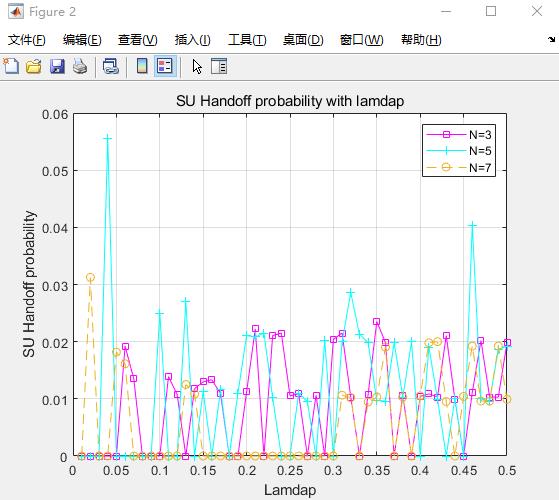CR网络和主网络的认知无线电切换算法
Posted fpga&matlab
tags:
篇首语:本文由小常识网(cha138.com)小编为大家整理,主要介绍了CR网络和主网络的认知无线电切换算法相关的知识,希望对你有一定的参考价值。
1. CR网络和主网络(授权网络)共同存在于同一区域,并且使用同一频段。假设该频段共有N个信道,每个主用户或CR用户每次接入只占用一个信道。若所有信道均被主用户占用,此时CR用户到达就被阻塞。若CR用户正在使用的信道有主用户出现,此时CR用户被迫中断,并进入缓存区排队等待空闲可用信道以继续刚被中断的通信,若等待超过一定时限,则判定CR用户强制中断退离缓存区。
2. 主用户和次用户的到达服从泊松分布,参数分别为lambdap和lambdas,平均服务时间服从参数为mup和mus的负指数分布
3. 对次用户而言,主用户抢占优先。总共有N个信道,也就是最多可以有N个主用户抢占所有信道,故Z队列的长度不会超过N,这里给定Z队列长度为N。
4. 假设初始状态所有N个信道均空闲,次用户理想感知,感知延时为0.005
clear
clc
rand('twister',0);
blockpu=[];
blocksu=[];
for N=3:2:7
block=[];
for lambdap =0.01:0.01:0.5
%*****************************************
%初始化
%*****************************************
a = 10; %主用户数量
b = 100; %次用户数量
%N =2 %Z队列最大长度/总的信道数
%Tao=5;%切换时延门限Tao
A = [ ]; %某主用户到达时刻占用信道序号的集合
B = [ ]; %某次用户到达时刻占用信道序号的集合
C = [ ]; %切换用户占用的当前所有信道序号集合
D = [ ]; %某次用户到达时刻主用户占用信道集合
member = [ ];
member_CR = [ ];
j1=1;
%主用户参数*****************************************
%lambdap = 0.1;
mup =0.6; %主用户到达率与服务率
arr_meanp = 1/lambdap;
ser_meanp = 1/mup;%主用户平均到达时间与平均服务时间
arr_nump = a; %round(Total_time*lambdap*2);
tp = zeros(6,arr_nump);
tp(1,:) = exprnd(arr_meanp,1,arr_nump); %按负指数分布产生各主用户到达时间间隔
tp(1,:) = cumsum(tp(1,:)); %各主用户的到达时刻等于时间间隔的累积和
tp(2,:) = exprnd(ser_meanp,1,arr_nump); %按负指数分布产生各主用户服务时间
%次用户参数*****************************************
lambdas =0.4;
mus =0.7; %次用户到达率与服务率
arr_means = 1/lambdas;
ser_means = 1/mus; %次用户平均到达时间与平均服务时间
arr_nums = b;
ts = zeros(6,arr_nums);
ts(1,:) = exprnd(arr_means,1,arr_nums); %按负指数分布产生各次用户达到时间间隔
ts(1,:) = cumsum(ts(1,:)); %各次用户的到达时刻等于时间间隔的累积和
ts(2,:) = exprnd(ser_means,1,arr_nums); %按负指数分布产生各次用户服务时间
%切换用户参数*****************************************待计算lambdah和muh
arr_numh = 10; %切换用户排队长度设置
th = zeros(6,arr_numh);
tsh=[];
%*****************************************
%计算第1个主用户的信息
%*****************************************
if arr_nump>=1
tp(3,1) = 0; %第1个主用户进入系统后直接接受服务,无需等待
n = ceil(rand*N); %产生一个在N范围内的随机数作为接入的信道序号
tp(4,1) = tp(1,1)+tp(2,1); %其离开时刻等于其到达时刻与服务时间之和
tp(5,1) = 1; %其肯定被系统接纳,此时系统内共有1个主用户,故标志位置1
tp(6,1) = n; %依次记录主用户占用信道的序号
A=[A n];
member = [1]; %其进入系统后,系统内已有成员序号为1
else
!echo No Primary Users!!!!
end
%*****************************************
if arr_nums>=1
if arr_nump>=1
k1 = sum(ts(1,:) < tp(1,1));
if k1~=0
for i =1:k1
if i==1
ts(3,i) = 0.005; %其等待时间为 0
ts(4,i) = ts(1,i)+ts(2,i)+ts(3,i); %其离开时刻等于到达时刻与服务时间之和
ts(5,i) = 1; %其标志位置 1 ,即次用户在用当前信道
m = ceil(rand*N); %产生一个在N范围内的随机数作为接入的信道序号
ts(6,i) = m; %依次记录次用户占用信道的序号
B=[B m];
member_CR =[1];
handoff1=find(tp(1,:)>ts(1,i));
handoff2=find(tp(1,:)<ts(4,i));
if isempty(handoff1)==0&&isempty(handoff2)==0
handoff3=setdiff(handoff1,handoff2);%当前次用户通信期间(时间段)到达的主用户
handoff=setdiff(handoff1,handoff3);
handoff4=[];
for puid=1:length(handoff)
if tp(6,handoff(puid))==ts(6,i)
handoff4=[handoff4,handoff(puid)];
break;
end
end
if isempty(handoff4)==0
if j1<=arr_numh
th(1,j1)=tp(1,handoff4(1));
th(2,j1)=ts(4,i)-tp(1,handoff4(1));
ts(4,i)=tp(1,handoff4(1));
tsh=ts(:,i);
%切换到其他可用信道
num_arrivep=find(tp(1,:)<=th(1,j1));
num_leavep=find(tp(4,:)>=th(1,j1));
num_present1=setdiff(num_arrivep,num_leavep);
num_present2=setdiff(num_arrivep,num_present1);%当前在的主用户
num_arrives=find(ts(1,:)<th(1,j1));
num_leaves=find(ts(4,:)>th(1,j1));
num_present3=setdiff(num_arrives,num_leaves);
num_present4=setdiff(num_arrives,num_present3);%当前在的次用户
num_present6=[];
wait=0;
if j1>1
j2=1:j1-1;
num_arriveh=find(th(1,j2)<th(1,j1));
num_leaveh=find(th(4,j2)>th(1,j1));
num_present5=setdiff(num_arriveh,num_leaveh);
num_present6=setdiff(num_arriveh,num_present5);%当前在的切换用户
for j3=1:length(num_present6)
wait=wait+th(3,num_present6(j3));
end
th(3,j1)=wait;%切换用户排队等待时间
end
if length(num_present2)==N
wait1=tp(4,num_present2(1));
for k=1:length(num_present2)
wait1=min(tp(4,num_present2(k)),wait1);
end
for k=1:length(num_present2)
if wait1==tp(4,num_present2(k))
wait2=num_present2(k);
break;
end
end
th(3,j1)=wait1-th(1,j1)+th(3,j1);
th(4,j1)=th(1,j1)+th(2,j1)+th(3,j1);
th(5,j1)=1;
th(6,j1)=tp(6,wait2);
tsh=[tsh,th(:,j1)];
elseif isempty(num_present2)&&length(num_present4)==N
wait1=ts(4,num_present4(1));
for k=1:length(num_present4)
wait1=min(ts(4,num_present4(k)),wait1);
end
for k=1:length(num_present4)
if wait1==ts(4,num_present4(k))
wait3=num_present4(k);
break;
end
end
th(3,j1)=wait1-th(1,j1)+th(3,j1);
th(4,j1)=th(1,j1)+th(2,j1)+th(3,j1);
th(5,j1)=1;
th(6,j1)=ts(6,wait3);
tsh=[tsh,th(:,j1)];
elseif length(num_present2)+length(num_present4)==N&&isempty(num_present2)==0&&isempty(num_present4)==0
wait1=tp(4,num_present2(1));
for k=1:length(num_present2)
wait1=min(tp(4,num_present2(k)),wait1);
end
for k=1:length(num_present4)
wait1=min(ts(4,num_present4(k)),wait1);
end
tps=[tp(:,num_present2),ts(:,num_present4)];
for k=1:length(tps)
if wait1==tps(4,k)
wait4=k;
break;
end
end
th(3,j1)=wait1-th(1,j1)+th(3,j1);
th(4,j1)=th(1,j1)+th(2,j1)+th(3,j1);
th(5,j1)=1;
th(6,j1)=tps(6,wait4);
tsh=[tsh,th(:,j1)];
elseif length(num_present2)+length(num_present4)<N
channel1=[tp(6,num_present2),ts(6,num_present4)];
channel=setdiff([1:N],channel1);
th(3,j1)=0.006+th(3,j1);
th(4,j1)=th(1,j1)+th(2,j1)+th(3,j1);
th(5,j1)=1;
th(6,j1)=channel(1);
tsh=[tsh,th(:,j1)];
end
j1=j1+1;
end
end
end
elseif i >= 2
j=1:i-1;
number_CR = find(ts(4,j) > ts(1,i)); %当前占用信道的次用户个数
[th1,th2]=find(th==0);
th(:,th2)=[];
if isempty(number_CR)&&isempty(th)
m = ceil(rand*N); %产生一个在N范围内的随机数作为接入的信道序号
ts(3,i) = 0.005;
ts(4,i) = ts(1,i)+ts(2,i)+ts(3,i); %其离开时刻等于到达时刻与服务时间之和
ts(5,i) = 1; %其标志位置 1 ,即次用户在用当前信道
ts(6,i) = m; %依次记录次用户占用信道的序号
B=[B m];
member_CR = [member_CR,i];
handoff1=find(tp(1,:)>ts(1,i));
handoff2=find(tp(1,:)<ts(4,i));
if isempty(handoff1)==0&&isempty(handoff2)==0
handoff3=setdiff(handoff1,handoff2);%当前次用户通信期间(时间段)到达的主用户
handoff=setdiff(handoff1,handoff3);
handoff4=[];
for puid=1:length(handoff)
if tp(6,handoff(puid))==ts(6,i)
handoff4=[handoff4,handoff(puid)];
break;
end
end
if isempty(handoff4)==0
if j1<=arr_numh
th(1,j1)=tp(1,handoff4(1));
th(2,j1)=ts(4,i)-tp(1,handoff4(1));
ts(4,i)=tp(1,handoff4(1));
tsh=[tsh,ts(:,i)];
%切换到其他可用信道
num_arrivep=find(tp(1,:)<=th(1,j1));
num_leavep=find(tp(4,:)>=th(1,j1));
num_present1=setdiff(num_arrivep,num_leavep);
num_present2=setdiff(num_arrivep,num_present1);%当前在的主用户
num_arrives=find(ts(1,:)<th(1,j1));
num_leaves=find(ts(4,:)>th(1,j1));
num_present3=setdiff(num_arrives,num_leaves);
num_present4=setdiff(num_arrives,num_present3);%当前在的次用户
num_present6=[];
wait=0;
if j1>1
j2=1:j1-1;
num_arriveh=find(th(1,j2)<th(1,j1));
num_leaveh=find(th(4,j2)>th(1,j1));
num_present5=setdiff(num_arriveh,num_leaveh);
num_present6=setdiff(num_arriveh,num_present5);%当前在的切换用户
for j3=1:length(num_present6)
wait=wait+th(3,num_present6(j3));
end
th(3,j1)=wait;%切换用户排队等待时间
end
if length(num_present2)==N
wait1=tp(4,num_present2(1));
for k=1:length(num_present2)
wait1=min(tp(4,num_present2(k)),wait1);
end
for k=1:length(num_present2)
if wait1==tp(4,num_present2(k))
wait2=num_present2(k);
break;
end
end
th(3,j1)=wait1-th(1,j1)+th(3,j1);
th(4,j1)=th(1,j1)+th(2,j1)+th(3,j1);
th(5,j1)=1;
th(6,j1)=tp(6,wait2);
tsh=[tsh,th(:,j1)];
elseif isempty(num_present2)&&length(num_present4)==N
wait1=ts(4,num_present4(1));
for k=1:length(num_present4)
wait1=min(ts(4,num_present4(k)),wait1);
end
for k=1:length(num_present4)
if wait1==ts(4,num_present4(k))
wait3=num_present4(k);
break;
end
end
th(3,j1)=wait1-th(1,j1)+th(3,j1);
th(4,j1)=th(1,j1)+th(2,j1)+th(3,j1);
th(5,j1)=1;
th(6,j1)=ts(6,wait3);
tsh=[tsh,th(:,j1)];
elseif length(num_present2)+length(num_present4)==N&&isempty(num_present2)==0&&isempty(num........................

D101
以上是关于CR网络和主网络的认知无线电切换算法的主要内容,如果未能解决你的问题,请参考以下文章